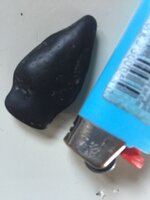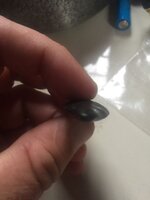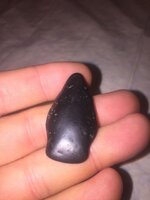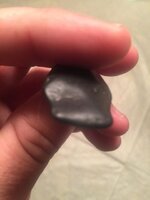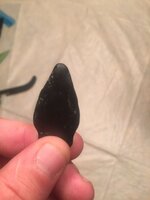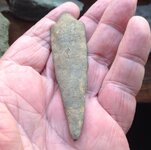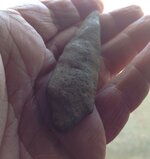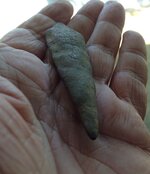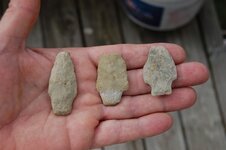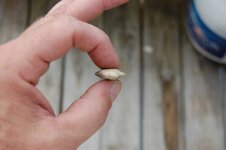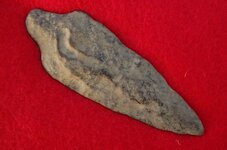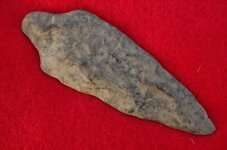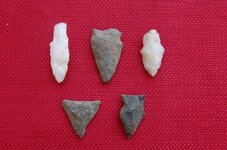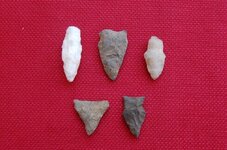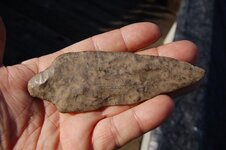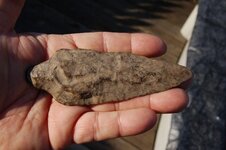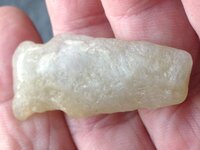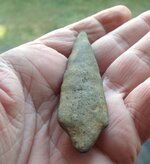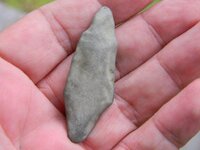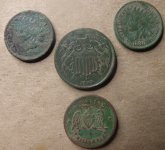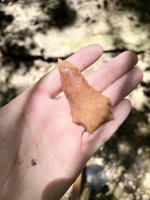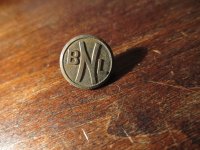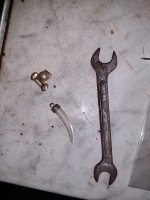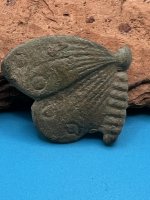You are using an out of date browser. It may not display this or other websites correctly.
You should upgrade or use an alternative browser.
You should upgrade or use an alternative browser.
Point identification needed
- Thread starter Vikingblood
- Start date
Vikingblood
Full Member
- Sep 25, 2013
- 212
- 58
- Primary Interest:
- All Treasure Hunting
- Thread starter
- #21
Well, all I can add, is that there is no rocks of this type on the beaches of New Jersey at all. Obsidian can be found in New Jersey, far from the beach. I apologize if I have wasted your time Hot Diggity, since it's "useless to even think about" If it's a rock that looks like a point, that's fine. I will chuck it. No big deal.
Vikingblood
Full Member
- Sep 25, 2013
- 212
- 58
- Primary Interest:
- All Treasure Hunting
- Thread starter
- #22
Hot diggity
Sr. Member
- Nov 19, 2014
- 441
- 313
Not what I'm saying at all! Hold on to it. Just don't try to pass it off as something u can't prove. Look at it. Sorry
Last edited:
Hot diggity
Sr. Member
- Nov 19, 2014
- 441
- 313
Or toss it. I couldn't care less. Nothing to suggest anything
Charl
Silver Member
That's what I thought, it looks pretty thick. It is not a point. I don't know why so many people here are so quick with compliments, or eager to call some things an artifact when they clearly are not.
quito, see the long, completely water worn Stark point I posted. I do completely appreciate your point of view, but this was not a case of calling something an artifact that was not an artifact. Necessarily, that is. I have posted several examples of definite points water worn to the point of the flaking being gone, or all but gone. So, what I said was not to simply pay a compliment, or being eager to call a geofact an artifact. But, obviously, it really helps if one does have a lot of experience with water worn points. If, shown at all angles, it conforms to what you would expect from a bifacial point, and if we could confirm it was a known liithic, such as a black flint, then no, we cannot just dismiss it as a geofact. Water worn "erased points"(entirely my own made-up term) do exist. In high energy tidal zones. That little piece could indeed be a water worn point. As far as never being able to "prove it", well, I don't know if that can be said. It would be odd, for example, for a piece of black flint to conform in all particulars to what one would expect to see in the form of a bifacial projectile point. In this instance, if other photos are posted, showing the outline tip head on, and if it's a known lithic, I probably would be inclined to think it is a water worn point. But, unfortunately I might add, such points are too often what we find here. Material like argillite and quartz, which dominate here, are very subject to this kind of severe water weathering....
Charl
Silver Member
Vikingblood, I should think it a type of flint before I settled on obsidian. Thank you the additional photos, as requested. It has the correct bi convex outline looking at the tip head on(I think!). If it is a point, it's as water worn as it gets. And I certainly don't blame other experienced eyes for saying geofact, not artifact. It's hard to know with certainty, but I would not toss it. Maybe some would say the Stark point I posted cannot be proven to be a point. Yet, there is no doubt in my mind, or in the minds of anyone who collects on southern New England beaches, that it is without any doubt whatsoever, a Stark point. There is no doubt if you are an experienced collector from southern New England. So, if you can determine your piece is made of flint, yes, it could be an extremely water worn piece, and I would not toss it.
i honestly suspected these divergent opinions would emerge here. It's inevitable. Very few collectors in general collect in high energy tidal zones where erasure of flaking can, and does, occur. I do. I have a friend with a frame of entirely water worn points, many all but erased. All types of lithics and styles. But he will never tell me where he finds them, because it's a really hot spot honey hole. But, for certain, he's finding them in a high energy tidal zone.
i honestly suspected these divergent opinions would emerge here. It's inevitable. Very few collectors in general collect in high energy tidal zones where erasure of flaking can, and does, occur. I do. I have a friend with a frame of entirely water worn points, many all but erased. All types of lithics and styles. But he will never tell me where he finds them, because it's a really hot spot honey hole. But, for certain, he's finding them in a high energy tidal zone.
Charl
Silver Member
Decided to photograph the Stark point to show that, only in the sharpest angled light, can I even detect that this point was ever flaked. I think now this is made of one of our regional rhyolites. But a great example of an "erased point". If your point were made of flint, for example, the question would become: is it simply a coincidence that it conforms to what one expects a bifacial projectile to look like from every single angle shown? In other words, just a cool geofact? Or is it a water worn point? Different folks, different calls I guess. I go with point when all the angles conform to a point, and the material is a lithic known to be used by the natives. And I usually have all the confidence in the world when making the call. But, I am not holding your piece, and don't know if it's a known lithic. As noted, if it were a water polished black shale, it would be a geofact.
Attachments
Hot diggity
Sr. Member
- Nov 19, 2014
- 441
- 313
Fine. I know nothing of tides (being inland) - But that's a hell of a lot of erosion on that "point". Ya'd never know. (The original post) I personally say no.
Last edited:
theviking
Bronze Member
Vikingblood, I should think it a type of flint before I settled on obsidian. Thank you the additional photos, as requested. It has the correct bi convex outline looking at the tip head on(I think!). If it is a point, it's as water worn as it gets. And I certainly don't blame other experienced eyes for saying geofact, not artifact. It's hard to know with certainty, but I would not toss it. Maybe some would say the Stark point I posted cannot be proven to be a point. Yet, there is no doubt in my mind, or in the minds of anyone who collects on southern New England beaches, that it is without any doubt whatsoever, a Stark point. There is no doubt if you are an experienced collector from southern New England. So, if you can determine your piece is made of flint, yes, it could be an extremely water worn piece, and I would not toss it.
i honestly suspected these divergent opinions would emerge here. It's inevitable. Very few collectors in general collect in high energy tidal zones where erasure of flaking can, and does, occur. I do. I have a friend with a frame of entirely water worn points, many all but erased. All types of lithics and styles. But he will never tell me where he finds them, because it's a really hot spot honey hole. But, for certain, he's finding them in a high energy tidal zone.
I agree. I've found several "erased points" here as well, and I am hundreds of miles from the beach in the Shenandoah mountains. These points came from one of our garden beds a few hundred feet above the creek, along with many other easily recognized artifacts. Poor quality material and the right soil conditions caused this,IMHO. Maybe the high acidic content of the soil. The two on the left I think are Rhyolite, the other is Quartzite. I have other examples of the same material showing different levels of degradation.
Attachments
Hot diggity
Sr. Member
- Nov 19, 2014
- 441
- 313
Ugh. Those are good examples of worn points theviking. The original post is not.
theviking
Bronze Member
Ugh. Those are good examples of worn points theviking. The original post is not.
You maybe correct. It just seems a little to coincidental to say definitely not.
Hot diggity
Sr. Member
- Nov 19, 2014
- 441
- 313
I take back everything I said. It's totally possible.
Trooper733
Sr. Member
- Apr 3, 2013
- 388
- 315
- Detector(s) used
- Whites V3i,Whites DFX, Whites TRX, Garrett Pro Pointer
- Primary Interest:
- Other
I at least learned something, never having lived or hunted points in a tidal zone I have never seen anything like those posted by Charl and Viking. Sometimes it is obvious one way or the other whether a find is a geofact or and artifact, but it seems there are sometimes quick calls made on here for and against something found being a rock/artifact when there isn't enough information to call one way or the other, especially without seeing the rock/artifact in person or much more detailed photos. Its healthy to debate but it gets pretty ganky and disrespectful sometimes which gets REALLY OLD. Posit a hypothesis, gather information/evidence pro and con to prove/disprove the hypothesis, debate it defending your stance respectfully.
Thanks Viking, Charl, and others for sharing your knowledge and finds. I definitely learned something new, we don't see points worn to that level with points found in rivers and creeks here.
Thanks Viking, Charl, and others for sharing your knowledge and finds. I definitely learned something new, we don't see points worn to that level with points found in rivers and creeks here.
Hot diggity
Sr. Member
- Nov 19, 2014
- 441
- 313
...& sometimes ppl mix drinks with posts then regret it later.
Trooper733
Sr. Member
- Apr 3, 2013
- 388
- 315
- Detector(s) used
- Whites V3i,Whites DFX, Whites TRX, Garrett Pro Pointer
- Primary Interest:
- Other
That is hilarious!
The Grim Reaper
Gold Member
After seeing that second set of pictures I think it just may be a very water worn Point. It definitely has the shape and like Charl I have a few from the beaches of the Atlantic that have almost all of the flake scars erased off by water wear. This large Blade and Brewerton are from Connecticut and both found along the beach.
Attachments
Charl
Silver Member
Here is a good example of a quartz side notch from the surf zone. Basically, such an environment acts the same as a rock tumbler. This quartz point will eventually be completely smoothed over, and the only clue it was a point might be the side notches themselves. I don't have any good flint examples, but only about 1 point in 50 we find is made of flint. Sometimes I think of points like this one as an artifact on it's way to becoming a geofact. Well, not really, since once an artifact, always an artifact. This one came from the beach with the highest energy tidal zone we hunt. You can at least see how over time the flaking is erased. Eventually, there would not be so much as a dimple in the skin of this point. You can already see broad smooth patches forming. Again, if I threw it in a rock tumbler for a spell, I might finish the job. A high energy tidal zone is rocks, sand, gravel, and daily waves during the change of tides. It "erases" points. Double click this photo to see how "erased" this point is becoming. They do get to the point where the skin is 100% smooth. It happens. To quartz. And it happens to flint as well. Erased so the skin is 100% smooth, and only the shape will betray the fact that it is a water worn projectile point. Hunt high energy tidal zones, and you will find such erased points. If the skin on this quartz point were 100% smooth, would you still recognize it as a point? I would.....
Finally, a better photo of that rhyolite Stark point. Can you see it has 100% erasure of the flaking? Double click it and see that the skin is completely smoothed out by being beach tumbled. It's the best example in this thread of what I'm describing. And remember, it isn't just water that does that to a point. The surf zone is like a rock tumbler. It is being heavily abraded by rocks and gravel as well as water. The main difference with a flint point, is the flint point is likely to be glossy. Sorry I don't have any black chert/flint examples to show, but the same principle certainly applies. The points will become completely erased and smooth as a baby's skin, and you'll be left judging it by form alone at times.....
Again, no effort on my part to deceive the poster or tell him something he wants to hear. Erased points exist and can be recognized by collectors accustomed to finding them. Is the piece at the center of this thread such an example? I can't say with certainty at all, but the existence of erased points is the reason I did not reject it completely. The fact that it shows the cross section form I would expect, regardless of in which direction it's viewed, did indeed raise my suspicions that it might be what I've come to call an "erased point." Tell me it's flint, and I might just frame it as just such an example.
Finally, a better photo of that rhyolite Stark point. Can you see it has 100% erasure of the flaking? Double click it and see that the skin is completely smoothed out by being beach tumbled. It's the best example in this thread of what I'm describing. And remember, it isn't just water that does that to a point. The surf zone is like a rock tumbler. It is being heavily abraded by rocks and gravel as well as water. The main difference with a flint point, is the flint point is likely to be glossy. Sorry I don't have any black chert/flint examples to show, but the same principle certainly applies. The points will become completely erased and smooth as a baby's skin, and you'll be left judging it by form alone at times.....
Again, no effort on my part to deceive the poster or tell him something he wants to hear. Erased points exist and can be recognized by collectors accustomed to finding them. Is the piece at the center of this thread such an example? I can't say with certainty at all, but the existence of erased points is the reason I did not reject it completely. The fact that it shows the cross section form I would expect, regardless of in which direction it's viewed, did indeed raise my suspicions that it might be what I've come to call an "erased point." Tell me it's flint, and I might just frame it as just such an example.
Attachments
Last edited:
Trooper733
Sr. Member
- Apr 3, 2013
- 388
- 315
- Detector(s) used
- Whites V3i,Whites DFX, Whites TRX, Garrett Pro Pointer
- Primary Interest:
- Other
Now THAT is a fine example of using the scientific method in explaining and defending a hypothesis!
Charl
Silver Member
Thank you, Trooper733. Not to beat a dead horse, but I just came across this photo, and it's too good an example not to include here. Another Middle Archaic Stark point. New England argillite, or argillaceous slate. Here, the "erasure" of the flaking is virtually complete. This might pass for a flat pebble. But, since it's argillite, with the shape of a Stark point, it's no pebble. It's a point. And slate is the kind of material one can easily visualize this happening to. Not a material that will be very resistant to weathering of any type. In a high energy surf zone, forget it. Doesn't stand a chance given enough time and enough tumbling.
Attachments
Get-the-point
Bronze Member
Chiming in.....this post has run errant with examples.....the original poster has put more pics showing this piece again and what I see is a extremely water worn point. Material looks to be what the old timers call Black Jasper in NJ. I find this material alot in NJ and PA. It could be highly polished slate as well.
 Argillite is a soft material and is commonly eroded away into nothing sometimes, however the design seems to remain. When washing a fresh found argillite point it will actually turn the water the color of the argillite. Very informative Charl and some fine examples................GTP
Argillite is a soft material and is commonly eroded away into nothing sometimes, however the design seems to remain. When washing a fresh found argillite point it will actually turn the water the color of the argillite. Very informative Charl and some fine examples................GTP

Users who are viewing this thread
Total: 2 (members: 0, guests: 2)
